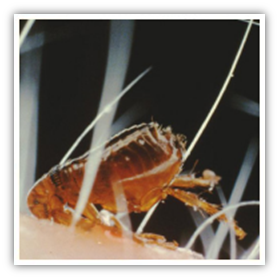Diseases from fleas
Fleas are small biting, jumping insects that live in the fur of many different animals. Cat and dog fleas are the most likely fleas to affect humans, though rats and raccoons nesting in a home can also carry fleas. While their bites can cause severe itching and skin infections, they can also spread diseases such as cat-scratch fever, typhus and plague to people.
Bites from fleas on wild animals should be avoided in rural areas by staying away from animal burrows where fleas breed. Fleas on cats and dogs can be prevented by the use of topical insecticide drops or shampoos. Unhatched flea eggs in carpets can be killed with "flea bomb" insecticides, available from veterinary clinics.
-
Cat Scratch Disease
- Flea control, Companion Animal Parasite Control Council
- Fighting Fleas and Ticks (FDA)
- Prevention & Control of Fleas (Illinois Dept of Public Health)
- Plague
Plague is a serious infection of humans caused by a bacteria called Yersinia pestis. It is usually caused by the bite of a flea that has fed on an infected wild animal, such as a rat, chipmunk or prairie dog. It usually causes large sores and abscesses in the glands of the arms and legs. Dogs, and especially cats, can also become infected and can spread the disease to their human companions. While plague has been found in wildlife in many parts of the state including Western Washington, human cases are rare. The most recent human case was in Grant County in 1984. Plague is treatable with antibiotics.
Cat scratch disease is a bacterial disease caused by Bartonella henselae. People with weak immune systems are at increased risk of getting seriously ill with cat scratch fever. Young cats and kittens are most likely to be the source of human infection and about 40% of cats carry these bacteria at some point in their lives. The infection, which rarely causes disease in cats, is transmitted between cats by fleas. Infected flea droppings on the cat's fur or claws are the source of human infections, which are spread from the cat to a person by a cat bite, scratch or lick. Cat scratch fever can be prevented by practicing effective flea control and by avoiding cat bites or scratches.

 Translate
Translate
